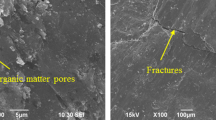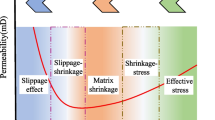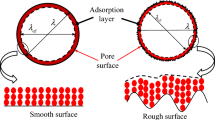Abstract
The influences of fractal pore structure in coal reservoir on coalbed methane (CBM) migration were analyzed in detail by coupling theoretical models and numerical methods. Different types of fractals were generated based on the construction thought of the standard Menger Sponge to model the 3D nonlinear coal pore structures. Then a correlation model between the permeability of fractal porous medium and its pore-size-distribution characteristics was derived using the parallel and serial modes and verified by Lattice Boltzmann Method (LBM). Based on the coupled method, porosity (φ), fractal dimension of pore structure (D b ), pore size range (r min, r max) and other parameters were systematically analyzed for their influences on the permeability (κ) of fractal porous medium. The results indicate that: ① the channels connected by pores with the maximum size (r max) dominate the permeability κ, approximating in the quadratic law; ② the greater the ratio of r max and r min is, the higher κ is; ③ the relationship between D b and κ follows a negative power law model, and breaks into two segments at the position where D b ≌2.5. Based on the results above, a predicting model of fractal porous medium permeability was proposed, formulated as κ=Cfr nmax , where C and n (approximately equal to 2) are constants and f is an expression only containing parameters of fractal pore structure. In addition, the equivalence of the new proposed model for porous medium and the Kozeny-Carman model κ=Cr n was verified at D b =2.0.
Similar content being viewed by others
References
Yao Y, Liu D, Tang D, et al. Fractal characterization of seepage-pores of coals from china: An investigation on permeability of coals. Comput Geo Sci, 2009, 35: 1159–1166
Yao Y, Liu D. Adsorption characteristics of coal reservoirs in North China and its influencing factors (in Chinese). J China Univ Min Tech, 2007, 36: 308–314
Karacan C O, Okandan E. Adsorption and gas transport in coal microstructure: Investigation and evaluation by quantitative X-ray ct imaging. Fuel, 2001, 80: 509–520
Gilman A, Beckie R. Flow of coal-bed methane to a gallery. Transport Porous Media, 2000, 41: 1–16
Clarkson C R, Bustin R M. The effect of pore structure and gas pressure upon the transport properties of coal: A laboratory and modeling study. 1. Isotherms and pore volume distributions. Fuel, 1999, 78: 1333–1344
Zhang S, Tang S, Tang D, et al. Fractal characteristics of coal reservoir seepage pore, East Margin of Ordos Basin (in Chinese). J China Univ Min Tech, 2009, 38: 713–718
Yao Y, Liu D, Tang D, et al. Fractal characterization of adsorption- pores of coals from north china: An investigation on Ch4 adsorption capacity of coals. Int J Coal Geol, 2008, 73: 27–42
Zhang S, Tang D, Tang S, et al. The characters of coal beds micropores and its influence factors in the Eastern Margin of Ordos Basin (in Chinese). Acta Geol Sin, 2008, 82: 1341–1349
Fu X, Qin Y, Zhang W, et al. Fractal classification and natural classification of coal pore structure based on migration of coal bed methane. Chin Sci Bull, 2005, 50: 66–71
Wang W F, X L, Fu X H. Study on pore texture of coal with fractal theory (in Chinese). Coal Geol China, 2002, 14: 26–27
Fu X H, Qin Y, Xue X Q, et al. Research on fractals of pore and fracture-structure of coal reservoirs (in Chinese). J China Univ Min Tech, 2001, 30: 225–228
Mitra A, Harpalani S, Liu S. Laboratory measurement and modeling of coal permeability with continued methane production (I): Laboratory results. Fuel, 2012, 94: 110–116
Liu S, Harpalani S, Pillalamarry M. Laboratory measurement and modeling of coal permeability with continued methane production (II): Modeling results. Fuel, 2012, 94: 117–124
Pan Z, Connell L D. Modelling permeability for coal reservoirs: A review of analytical models and testing data. Int J Coal Geol, 2012, 92: 1–44
Liu J, Chen Z, Elsworth D, et al. Interactions of multiple processes during cbm extraction: A critical review. Int J Coal Geol, 2011, 87: 175–189
Xu H, Sang S, Fang L, et al. Production characteristics and the control factors of surface wells for relieved methane drainage in the Huainan mining area. Acta Geol Sin-English Ed, 2011, 85: 932–941
Cai Y, Liu D, Yao Y, et al. Fractal characteristics of coal pores based on classic geometry and thermodynamics models. Acta Geol Sin, 2011, 85: 1150–1162
Connell L D, Lu M, Pan Z. An analytical coal permeability model for tri-axial strain and stress conditions. Int J Coal Geol, 2010, 84: 103–114
Fu X, Qin Y, Wang G X, et al. Evaluation of coal structure and permeability with the aid of geophysical logging technology. Fuel, 2009, 88: 2278–2285
Kaviany M. Principles of Heat Transfer in Porous Media. Berlin: Springer, 1995
Jacob B. Dynamics of Fluids in Porous Media. New York: Elsevier Science, 1972
Cai J, Huai X. Study on fluid-solid coupling heat transfer in fractal porous medium by lattice boltzmann method. Appl Therm Eng, 2010, 30: 715–723
Croce G, D Agaro P, Nonino C. Three-dimensional roughness effect on microchannel heat transfer and pressure drop. Int J Heat Mass Transfer, 2007, 50: 5249–5259
Nithiarasu P, Ravindran K. A new semi-implicit time stepping procedure for buoyancy driven flow in a fluid saturated porous medium. Comput Method Appl M, 1998, 165: 147–154
Nithiarasu P, Seetharamu K N, Sundararajan T. Natural convective heat transfer in a fluid saturated variable porosity medium. Int J Heat Mass Transfer, 1997, 40: 3955–3967
Sangani A S, Acrivos A. Slow flow past periodic arrays of cylinders with application to heat transfer. Int J Multiphase Flow, 1982, 8: 193–206
Ladd A J C. Numerical simulations of particulate suspensions via a discretized boltzmann equation. Part 2. Numerical results. J Fluid Mech, 1994, 271: 311–339
Ladd A J C. Numerical simulations of particulate suspensions via a discretized boltzmann equation (I): Theoretical foundation. J Fluid Mech, 1994, 271: 285–309
Koponen A, Kataja M, Timonen J. Permeability and effective porosity of porous media. Phys Rev E: Stat Phys Plasmas Fluids, 1997, 56: 3319–3325
Chen S, Doolen G D. Lattice boltzmann method for fluid flows. Ann Rev Fluid Mech, 1998, 30: 329–364
Kandhai D, Vidal D, Hoekstra A G, et al. A comparison between lattice-boltzmann and finite-element simulations of fluid flow in static mixer reactors. Int J Modern Phys C-Phys Comput, 1998, 9: 1123–1128
Kandhai D, Vidal D, Hoekstra A G, et al. Lattice-boltzmann and finite element simulations of fluid flow in a smrx static mixer reactor. Int J Numer Methods Fluids, 1999, 31: 1019–1033
Succi S. The Lattice Boltzmann Equation for Fluid Dynamics and Beyond. Oxford: Clarendon Press, 2001
Nourgaliev R R, Dinh T N, Theofanous T G, et al. The lattice boltzmann equation method: Theoretical interpretation, numerics and implications. Int J Multiphase Flow, 2003, 29: 117–169
Keehm Y. Computational rock physics: Transport properties in porous media and applications. Doctoral Dissertation. Stanford: Stanford University, 2003
Malaspinas O, Fiétier N, Deville M. Lattice boltzmann method for the simulation of viscoelastic fluid flows. J Non-Newtonian Fluid Mech, 2010, 165: 1637–1653
Guo Z, Zhao T S. A lattice boltzmann model for convection heat transfer in porous media. Numer Heat Transfer, Part B, 2005, 47: 157–177
Qian J, Li Q, Yu K, et al. A novel method to determine effective thermal conductivity of porous materials. Sci China Ser E-Tech Sci, 2004, 47: 716–724
Vita M C, De Bartolo S, Fallico C, et al. Usage of infinitesimals in the Menger’s sponge model of porosity. Appl Math Comput, 2012, 218: 8187–8195
Jin Y. Quantitative description of coal’s microstructure and numerical simulation analysis of its transport property (in Chinese). Doctoral Dissertation. Beijing: Peking University, 2011
Lu Q Q. Research on numeric simulation of gas migration and risk evaluation of gas aggregation in underground coal mine (in Chinese). Doctoral Dissertation. Xi’an: Xi’an University of Architecture and Technology, 2010
Xing Y F. Simulation of gas flow in underground coal seam based on LBM (in Chinese). Master Dissertation. Xi’an: Xi’an University of Architecture and Technology, 2009
Teng G, Tan Y, Gao M, et al. Simulation of gas drainage in fissured coal based on Lattice Boltzmann Method (in Chinese). J China Coal Soc, 2008, 33: 914–919
Teng G, Tan Y, Gao M. Simulation of gas seepage in fissured coal based on Lattice Boltzmann method (in Chinese). Chin J Rock Mech Eng, 2007, 26(Suppl 1): 3503–3508
Zhu Y, Tao G, Fang W, et al. Research progress of the klinkenberg effect in tight gas reservoir (in Chinese). Prog Geophys, 2007, 22: 1591–1596
Jin Y, Song H B, Pan J N, et al. Three-dimensional representation of coal’s microstructure and numerical analysis of its pore-permeability spatial-temporal evolution model (in Chinese). Chin J Rock Mech Eng, 2013, 32(Suppl 1): 2632–2641
Qin Y, Xu Z W, Zhang J. Natural classification of the high-rank coal pore structure and its application (in Chinese). J China Coal Soc, 1995, 20: 266–271
Tarafdar S, Franz A, Schulzky C, et al. Modelling porous structures by repeated sierpinski carpets. Physica A, 2001, 292: 1–8
Adler P M, Thovert J F. Fractal porous media. Transport Porous Media, 1993, 13: 41–78
Yuan L Y, Tao R. Experimental study of the conductivity exponent for some sierpinski carpets. Phys Lett A, 1986, 116: 284–286
Friesen W I, Mikula R J. Fractal dimensions of coal particles. J Colloid Interface Sci, 1987, 120: 263–271
Yu B, Li J. Some fractal characters of porous media. Fractals-An Interdiscipl J Complex Geometry, 2001, 9: 365–372
Huai X, Wang W, Li Z. Analysis of the effective thermal conductivity of fractal porous media. Appl Therm Eng, 2007, 27: 2815–2821
Dünweg B, Schiller U D, Ladd A J C. Progress in the understanding of the fluctuating lattice boltzmann equation. Comput Phys Commun, 2009, 180: 605–608
Dünweg B, Ladd A J C. Lattice boltzmann simulations of soft matter systems. Adv Polym Sci, 221: 89–166
Dünweg B, Schiller U D, Ladd A J C. Statistical mechanics of the fluctuating lattice boltzmann equation. Phys Rev E-Stat Phys Plasmas Fluids, 2007, 76: 36701–36704
Qian Y H, D’Humieres D, Lallemand P. Lattice bgk models for navier- stokes equation. Europhys Lett, 1992, 17: 479–488
Guo Z L, Zheng C G. Theory and Applications of Lattice Boltzmann Method (in Chinese). Beijing: Science Press, 2009
He Y L, Wang Y, Li Q. Lattice Boltzmann Method: Theory and Applications (in Chinese). Beijing: Science Press, 2009
Tuncer E, Gubanski S M, Nettelblad B. Dielectric relaxation in dielectric mixtures: Application of the finite element method and its comparison with dielectric mixture formulas. J Appl Phys, 2001, 89: 8092–8100
Mavko G, Mukerji T, Dvorkin J. The rock physics handbook: Tools for seismic analysis of porous media. London: Cambridge University Press, 1998
Author information
Authors and Affiliations
Corresponding author
Rights and permissions
About this article
Cite this article
Jin, Y., Song, H., Hu, B. et al. Lattice Boltzmann simulation of fluid flow through coal reservoir’s fractal pore structure. Sci. China Earth Sci. 56, 1519–1530 (2013). https://doi.org/10.1007/s11430-013-4643-0
Received:
Accepted:
Published:
Issue Date:
DOI: https://doi.org/10.1007/s11430-013-4643-0




